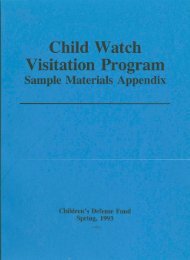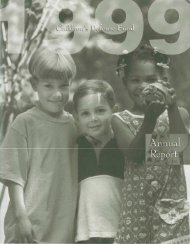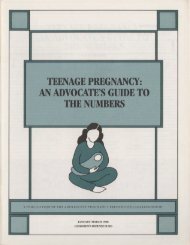child care - Digital Library Collections
child care - Digital Library Collections
child care - Digital Library Collections
Create successful ePaper yourself
Turn your PDF publications into a flip-book with our unique Google optimized e-Paper software.
THE STATE OF AMERICA'S CHILDREN YEARBOOK 1998<br />
courage the adoption of <strong>child</strong>ren with special<br />
needs-the Adoption Opportunities Act of 1978.<br />
Other legislation was enacted in the 1970s to<br />
protect the rights of particular groups of <strong>child</strong>ren.<br />
Most notably, Congress passed the Juvenile Justice<br />
and Delinquency Prevention Act, the Indian Child<br />
Welfare Act, the Developmentally Disabled Assistance<br />
and Bill of Rights Act, and the Education for<br />
All Handicapped Children Act. The 1974 enactment<br />
of the Title XX Social Services Program<br />
sparked hope of new services to prevent <strong>child</strong><br />
abuse and neglect, but these hopes diminished in<br />
1981 when Title XX funding was reduced and the<br />
program was made into a block grant. Today, funding<br />
for Title XX is at its lowest level since the<br />
program's inception.<br />
Building upon these earlier measures, the<br />
Adoption Assistance and Child Welfare Act in<br />
1980 attempted to restructure the federal government's<br />
role in protecting <strong>child</strong>ren and to encourage<br />
similar state efforts. The act's comprehensive approach<br />
to reform emphasized the need to (I) keep<br />
<strong>child</strong>ren from being unnecessarily placed in foster<br />
<strong>care</strong>, as well as the need to get them out; (2) link<br />
basic protections for cmldren and parents to state<br />
funding; (3) provide help in finding permanent<br />
homes for <strong>child</strong>ren free for adoption; and (4) monitor<br />
state progress in protecting <strong>child</strong>ren. Although<br />
implementation was mndered by efforts in the<br />
early 1980s to repeal or weaken the act, it stimulated<br />
the development of prevention and reunification<br />
services in some states and dramatically increased<br />
the adoption chances of <strong>child</strong>ren with<br />
special needs. The number of <strong>child</strong>ren who found<br />
permanent adoptive homes with federal assistance<br />
grew from an average of 165 a month in 1981 to<br />
more than 112,000 a month by 1997.<br />
Later federal legislative reforms prompted further<br />
state action. States undertook iilltiatives to<br />
help older youths in foster <strong>care</strong> prepare to live<br />
independently, promoted new methods of service<br />
delivery for <strong>child</strong>ren with serious emotional disturbances,<br />
and worked with communities to expand<br />
services that help families prevent or defuse problems.<br />
In addition, some states and commumties,<br />
often with foundation leadership and support, developed<br />
programs to promote adoption, permanency<br />
planning, specialized foster homes, famliy<br />
preservation, famiJy support, and, more recently,<br />
community partnerships for protecting <strong>child</strong>ren.<br />
Courts also have made state policies and practices<br />
more responsive to <strong>child</strong>ren's needs. In the<br />
• In 1996, 3.1 million <strong>child</strong>ren were reported abused or neglected,<br />
and the reports were substantiated for at least 969,000.<br />
• Eighty percent of the <strong>child</strong> welfare cases served in 1994 involved<br />
allegations of abuse or neglect, compared with 45 percent in 1977.<br />
• An estimated 40 to 80 percent of the families who become <strong>child</strong><br />
protective service cases have problems with alcohol or drugs.<br />
• Approximately 502,000 <strong>child</strong>ren were in foster <strong>care</strong> at the end of<br />
1996-about 25 percent more than in 1990.<br />
• In 1996, 2.14 million <strong>child</strong>ren lived in households headed by a<br />
relative with no parent present. A majority of these <strong>child</strong>ren-1.43<br />
million-lived with grandparents.<br />
64 CHI L D R EN' S D E FEN S E FUN D














